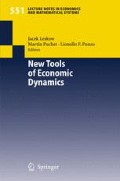Summary
The aim of this work is to present a new method of Value-at-Risk calculation using the fraction-of-time probability approach used in signal processing (see e.g Leśkow and Napolitano (2001)). This method allows making statistical type inferences based only on a single observation of phenomenon in time. Such setup is very convenient for time series data in financial analysis, when an assumption of having multiple realization of time series is very seldom realized. Another advantage of this method is the possibility of using it without assumptions on the distributions of returns. The aim of the paper is to present the method as well as application to financial data sets.
This paper was read at the 2nd. LA-EU Workshop “New tools of qualitative analysis of economic dynamics” in Cholula, Puebla, México, September 17th. and 18th, 2001
Access this chapter
Tax calculation will be finalised at checkout
Purchases are for personal use only
Preview
Unable to display preview. Download preview PDF.
References
Besicovitch, P. (1932), Almost-periodic functions, Cambridge University Press.
Engle, R. and Manganelli, S. (1999), CaViar: conditional autoregressive Value-at-Risk by regression quantiles, discussion paper 99-20, Department of Economics, University of California, San Diego.
Gardner, W.A. (1994), An introduction to cyclostationary signals, Chapter 1 in Cyclostationarity in Communications and Signal Processing, W.A. Gardner, Ed., pp. 1–90, IEEE Press, New York.
Izzo, L. and Napolitano, A. (1998), The higher-order theory of generalized almost-cyclostationary time-series, IEEE Trans. Signal Processing, vol. 46, pp. 2975–2989, November 1998.
Leśkow, J. (2001), The impact of stationarity assessment on studies of volatility and Value-at-Risk, Mathematic and Computer Modelling, vol. 34, pp. 1213–1222.
Leśkow, J. (2000), Value-at-Risk calculation and prediction in the fraction-of-time probability framework, preprint, Institute of Mathematics, Technical University of Wroclaw, Poland.
Leśkow, J. and Napolitano, A. (2002), Quantile prediction for time series in the fraction-of-time probability framework, Signal Processing, vol. 82, pp. 1727–1741.
Reiss, R.D. (1989), Approximate Distributions of Order Statistics, with applications to nonparametric statistics. Springer Series in Statistics. Urbanik, K. (1958), Effective processes in the sense of H. Steinhaus, Studia Mathematica, XVII.
Wiener, N. (1930), Generalized harmonic analysis, Acta Mathematica, vol. 55, pp.117–258.
Author information
Authors and Affiliations
Editor information
Editors and Affiliations
Rights and permissions
Copyright information
© 2005 Springer-Verlag Berlin Heidelberg
About this chapter
Cite this chapter
Leśkow, J., Napolitano, A. (2005). Fraction-of-Time Approach in Predicting Value-at-Risk. In: Leskow, J., Punzo, L.F., Anyul, M.P. (eds) New Tools of Economic Dynamics. Lecture Notes in Economics and Mathematical Systems, vol 551. Springer, Berlin, Heidelberg. https://doi.org/10.1007/3-540-28444-3_11
Download citation
DOI: https://doi.org/10.1007/3-540-28444-3_11
Publisher Name: Springer, Berlin, Heidelberg
Print ISBN: 978-3-540-24282-6
Online ISBN: 978-3-540-28444-4
eBook Packages: Business and EconomicsEconomics and Finance (R0)

